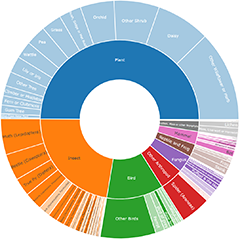Cup with one or more 'eggs' inside [birds nest fungi and cannonball fungus]
Most of the species in this category belong to what are called Birds nest fungi (the exception being the Cannonball fungus, Sphaerobolus stellatus).
Within the globular to vase-like fruit body of a Birds nest fungus there are ‘eggs’ (the peridioles). The fruit body may have a mouth, initially covered by a membrane (the epiphragm) which ruptures to expose the peridioles. Peridioles may be attached to the fruit body’s inner wall by a cord (the funiculus). Fruit bodies less than 2 cm in longest dimension (and often less than 1 cm).
Identification key (Based on mature fruit bodies)
1. Fruit body a yellowish cup (about 3 mm across), within which there is a single red-brown
peridiole. At maturity a thin, white, supporting membrane below the peridiole pops out
and so ejects the peridiole .................. Sphaerobolus stellatus (see note 1)
Not as above ......................................... 2
2. Fruit body globose or barrel-like, breaking irregularly, no epiphragm .......... 3
Fruit body cup-like or vase-like, with an epiphragm ......................................... 4
3. Fruit body very thin, ephemeral, white, up to 3 mm ......... Mycocalia
Fruit body robust, creamy to cinnamon, up to 10 mm ....... Nidularia
4. Peridioles loose (i.e. no funiculus) .................................... Nidula (but see note 2)
Peridioles attached (i.e. with funiculus) ............................ 5 or 5a
5. Fruit body roughly cyclindric (not tapering towards the base), yellow-brown,
exterior initially velvety or woolly (but may be smooth with age),
peridioles pale brown or whitish ................................................ Crucibulum laeve
Not as above ................................................................................. Cyathus
Crucibulum laeve is the only Crucibulum species known from Australia. Here is a more technical couplet (that allows for a Crucibulum species with a tapering base):
5a. Fruit body wall of one layer, funiculus a simple cord ................ Crucibulum
Fruit body wall of three distinct layers, funiculus complex
and composed of several distinct parts ...................................... Cyathus
Notes
1. The genus Sphaerobolus is quite distinct from the other genera, in both structure and peridiole release (photo at http://www.cpbr.gov.au/fungi/images-captions/sphaerobolus-stellatus-0141.html).
2. If the fruit body is very shaggy, with black peridioles, you may have Cyathus stercoreus, in which only the lower peridioles in a fruit body may have funiculi.
Announcements
There are currently no announcements.
Discussion
Sphaerobolus stellatus
Cyathus sp.
Cyathus sp.
Top contributors
- TimL 9
- Heino1 7
- trevorpreston 5
- CathB 5
- Teresa 3
- annamacdonald 3
- ruthkerruish 3
- ArcherCallaway 2
- KenT 2
- Illilanga 2
Top moderators
- Heino1 35
- Heinol 12
- MichaelMulvaney 10
- Heino 4
- Teresa 3
- Csteele4 2
- Pam 1
- trevorpreston 1
- robndane 1
- MichaelBedingfield 1






